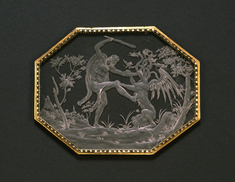Plaque with Hercules and Achelous
(Renaissance Europe )
This engraved plaque, along with Walters 41.70, show scenes from the life of the mythological hero Hercules and were initially set into a sumptuous, gilded casket that belonged to the ducal Gonzaga family of Mantua. Hercules was famous for his strength and virtue, and princes often surrounded themselves with his image as an ideal for (and an idealized image of) themselves.
The rivalry of Hercules and the river-god Achelous was narrated in the Roman poet Ovid's The Metamorphoses. Both were suitors of Deianira, the beautiful Greek maiden who became Hercules's wife. Annibale Fontana's genius as an engraver comes through in details such as the spiky underbrush of the riverbank and the shaggy lion's skin that Hercules wore.
Provenance
Provenance (from the French provenir, 'to come from/forth') is the chronology of the ownership, custody, or location of a historical object. Learn more about provenance at the Walters.
Henry Walters, Baltimore [date and mode of acquisition unknown]; Walters Art Museum, 1931, by bequest.
Exhibitions
| 2002-2003 | La Celeste Galleria dei Gonzaga. Il Museum dei duchi di Mantova tra Mantegna, Rubens e Guido Reni. Palazzo Te, Mantua. |
| 1971-1972 | World of Wonder. The Walters Art Gallery, Baltimore. |
Geographies
Italy, Milan (Place of Origin)
Measurements
H: 5 1/4 × W: 4 × D: 3/16 in. (13.3 × 10.2 × 0.5 cm)
Credit Line
Acquired by Henry Walters
Location in Museum
Accession Number
In libraries, galleries, museums, and archives, an accession number is a unique identifier assigned to each object in the collection.
In libraries, galleries, museums, and archives, an accession number is a unique identifier assigned to each object in the collection.
41.71



